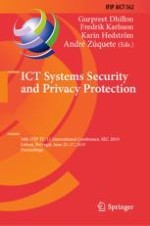2019 | Book
ICT Systems Security and Privacy Protection
34th IFIP TC 11 International Conference, SEC 2019, Lisbon, Portugal, June 25-27, 2019, Proceedings
Editors: Gurpreet Dhillon, Fredrik Karlsson, Karin Hedström, André Zúquete
Publisher: Springer International Publishing
Book Series : IFIP Advances in Information and Communication Technology
